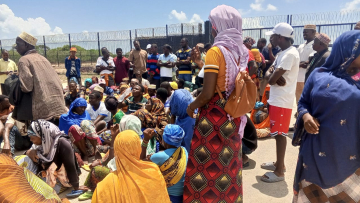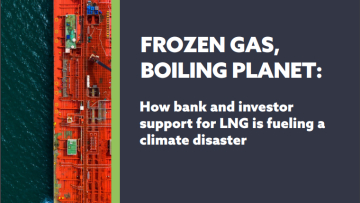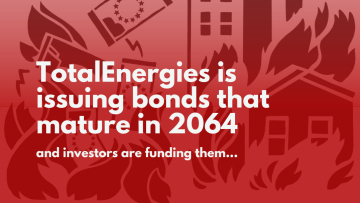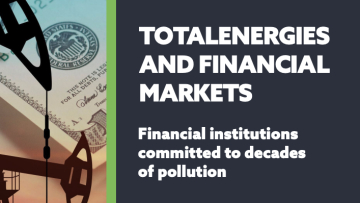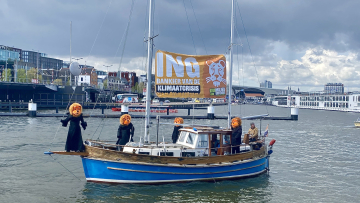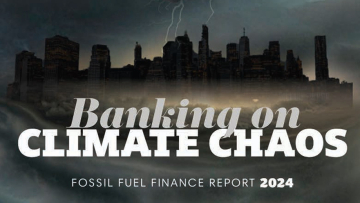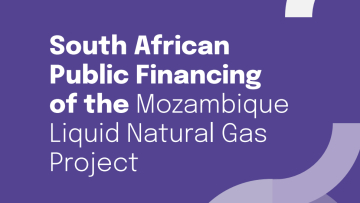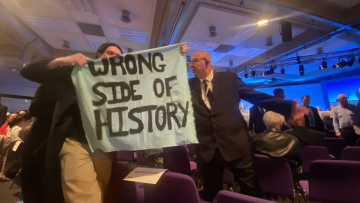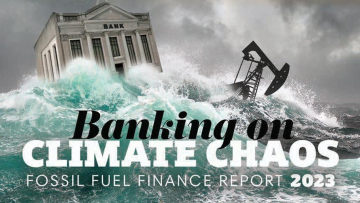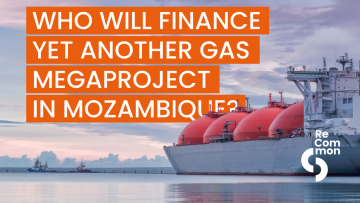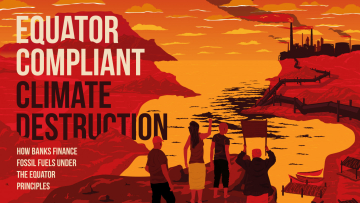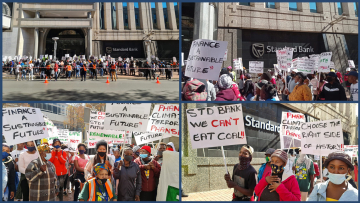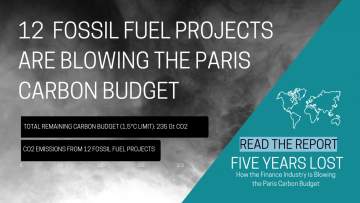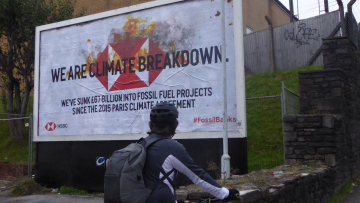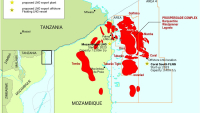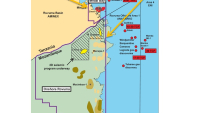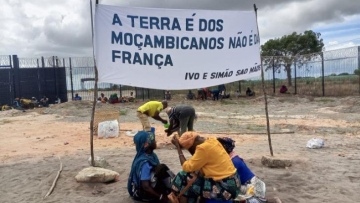
Project – Target
This profile is a priority campaign targetclimate@banktrack.org
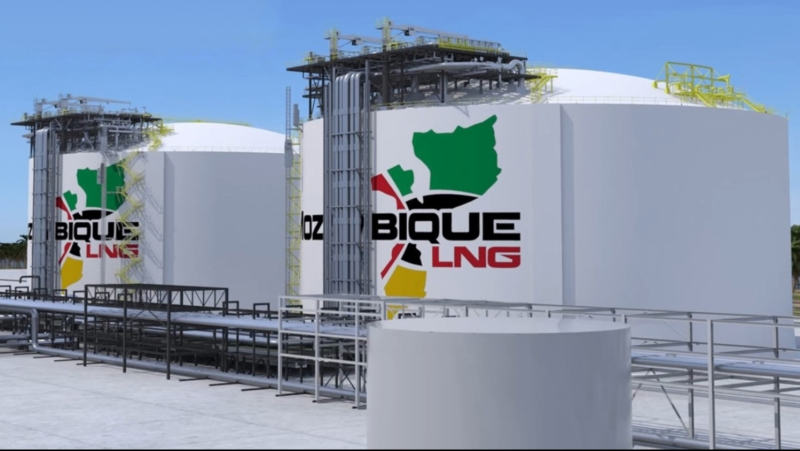
Project – Target
This profile is a priority campaign targetclimate@banktrack.org
Why this profile?
The Mozambique LNG project facilitates the export of an enormous quantity of gas. The project will displace thousands of people in the extraction zone, have serious, adverse impacts on ecosystems and wildlife and release millions of tonnes of greenhouse gases into the Earth’s atmosphere. No project that expands the fossil fuel industry is compatible with the Paris Climate Agreement.
What must happen
Banks and other financial institutions must refuse to finance this project. Such refusals would incentivise investment in, and the construction of renewable energy infrastructure in Africa, as opposed to fossil fuel infrastructure. TotalEnergies’ bank financiers must demand it to either abandon fossil fuel expansion and comply with the goals of the Paris Agreement, or forgo further finance.
| Sectors | Oil and Gas Extraction , LNG Terminal, Pipeline Transportation of Natural Gas |
| Location |
|
| Status |
Planning
Design
Agreement
Construction
Operation
Closure
Decommission
|
| Website | https://mzlng.totalenergies.co.mz/en |
|
|
This project has been identified as an Equator Project |
The TotalEnergies-backed Mozambique Liquified Natural Gas (LNG) project involves the extraction, liquefaction and transportation of gas from the Area 1 gas fields, which lie off the northern Mozambican coast. The gas is extracted from 20 offshore wells and transported onshore via a 40-kilometer pipeline to a 17,000-acre LNG facility. Once liquified, another pipeline transports the LNG to tankers destined for India and elsewhere. Initially producing 12.88 million tonnes of LNG annually, the facility has the potential to increase that figure to 43 million.
Impact on human rights and communities
Forced displacements to make way for the project have resulted in people losing their homes and livelihoods. As of March 2020, 556 families had been forcefully relocated, with a further 2,000 families due to follow. Fishing communities have been moved 10 kilometres inland, depriving them of their traditional income. Furthermore, Anadarko’s illogical displacement compensation methodology has led to locals who relinquished, for example, 10 hectares of land, being awarded a home and only one hectare of land that were not located near each other. For more information on the displacement and resettlement of particular villages, click here.
The project has failed to carry out mandatory community consultations, observe due process in pre-existing land rights expropriations, or provide fair compensation. According to the local NGO Centro Terra Viva Mozambique, these failures breach the law.
Militarisation of the gas region has resulted in violent attacks upon local communities. Insurgent attacks in northern Mozambique began in October 2017. In February 2019, a driver employed by the Portuguese construction company Gabriel Couto was killed during an attack on a Mozambique LNG Project convoy. During April 2020 alone, government forces killed more than 100 Islamist insurgents. In July 2020, militants killed eight TotalEnergies subcontractors. In response, the government has militarised the area and gas companies have contracted foreign private security firms, including the placement of the Russian paramilitary Wagner group in Cabo Delgado.
Despite an increased security presence in the region, by March 2020 locals claimed to be “living under constant fear of mistreatment by the military and by private security actors”. These locals have found themselves afraid to walk the long distances to the new, compensatory farmland they have been given, for fear of military harassment and attacks.
The spreading of COVID-19 to Mozambique’s Cabo Delgado province was attributed to the gas industry. An incoming TotalEnergies worker introduced the disease in April 2020, after which the Mozambique LNG Project construction site became the epicentre of the country’s COVID-19 crisis. TotalEnergie’s insufficient containment and testing policies meant that cooks, cleaners, security guards and other staff from surrounding villages interacted with infected TotalEnergies employees.
Media intimidation has resulted in many Cabo Delgado journalists being arrested or detained without charge, with some held in detention for months. The journalist Ibrahimo Abu Mbaruco went missing in April 2020, shortly after telling his mother that the military had arrested him; the local activist Mr Selemane disappeared in May 2020, 24 hours after speaking out against mistreatment at the hands of the military.
Seismic disturbances caused by gas field exploration affected local communities in the early 2010s. Seismic guns were used to locate the gas fields, which damaged the hearing of local harpoon fishermen; many were forced to suspend their fishing activities for extended periods of time, which impacted local food supplies and did not result in compensation.
Impact on climate
In 2014, Anadarko’s environmental impact assessment of the Mozambique LNG Project estimated its direct CO2 emissions at 12.9 million tonnes per year, from 2022 onwards. The facility will release a large amount of greenhouse gases, especially methane. The assessment underestimates the impact of methane that will be released, however. According to the Fifth Assessment Report of the IPCC, methane is 87 times more potent than CO2 over 20 years and this facility will leak it into the atmosphere during extraction, processing and transportation. When this is taken into consideration, the direct emissions of the Mozambique LNG Project are closer to 44.9 million tonnes.
Impact on nature and environment
The depletion of biodiversity in the area is spelled out in Anadarko’s own environmental impact assessment of the facility. Its location means that mangroves must be cleared, coastal seabeds and coral networks dredged and seagrass beds disturbed. Each of these represent important habitats for birds, reptiles and amphibians, the populations of which would consequently suffer. The introduction of invasive species from ballast shipping water would place further pressure on local biodiversity. The project threatens the Quirimbas National Park, which is also located in Cabo Delgado and has been designated a UNESCO Biosphere Reserve. These 11 islands incorporate a bird sanctuary for hundreds of species, a variety of reptiles, nearly 50 species of land mammals (including elephants, lions, buffalos and leopards), eight species of marine mammals and thousands of species of flora.
The endangerment of threatened species is anticipated owing to the facility’s location. A number of these, including the sei whale, the Indian yellow-nosed albatross and both the leatherback and hawksbill turtle, are considered imperilled by the International Union for Conservation of Nature.
Seismic disturbances during Anadarko’s surveying of the area have been criticised by environmental organisations for their damaging effects on marine animals. A 2011 report detailed the deaths of large numbers of shallow-water bottom-feeding sea-grass fish, shellfish and turtles following a shallow-water marine seismic programme along the northern coast of Mozambique in 2009.
Sociéte Générale is the financial advisor for the Mozambique LNG Project, which in 2017 was projected to cost USD 23 billion to develop. TotalEnergies is the majority shareholder, having bought Anadarko Petroleum Corporation’s 26.5% interest in September 2019.
In July 2020, TotalEnergies announced project finance worth USD 14.9 billion, secured via “direct and covered loans from eight Export Credit Agencies (ECAs), 19 commercial bank facilities, and a loan from the African Development Bank”.
Mozambique LNG is a joint venture of seven companies, as listed below.
Project sponsor
Other companies
Beas Rovuma Energy Mozambique
MozambiqueBPRL Ventures Mozambique
MozambiqueENH - Empresa Nacional de Hidrocarbonetos
MozambiqueMitsui
JapanONGC Videsh Limited (OVL)
IndiaPTTEP - PTT Exploration & Production
ThailandMap: Mozambique's existing and planned oil pipelines, LNG terminals and overlap with protected areas
Banking on Climate Chaos Case Study: Mozambique LNG Projects
Broken Lives, Stolen Future
2025
2025-07-31 00:00:00 | Civil society groups sue EXIM and call for UN human rights investigation
In two separate developments in July, Friends of the Earth International members launched a lawsuit against the US EXIM bank for its approval of $4.7 billion to support the Mozambique LNG project; and traditional leaders from Northern Mozambique formally requested the Office of the UN High Commissioner for Human Rights (OHCHR) to establish an independent investigation into severe human rights violations allegedly committed in 2021 by Mozambican security forces, including around the Mozambique LNG project.
2022
2022-02-01 00:00:00 | TotalEnergies acquires BP’s network in Mozambique
TotalEnergies has announced an agreement with BP to acquire a range of its oil assets. TotalEnergies will benefit from a new network of 26 service stations, reinforcing its position as Mozambique’s main petroleum products retailer.
2022-02-01 00:00:00 | TotalEnergies to resume Mozambique LNG project in 2022
TotalEnergies’ CEO Patrick Pouyanne has declared his intention to get the Mozambique LNG Project back on track this year, before admitting that there are still a number of security issues. The original timeline anticipated the project’s first LNG in 2025, followed by full production in 2026, but pervasive terrorism continues to destabilise the region (link in French).
2021
2021-08-27 00:00:00 | TotalEnergies Mozambique LNG Project may resume by 2023
According to the president of the African Development Bank, the Mozambique LNG Project could be back on track within 18 months. In response to violent insurgents, troops from Rwanda and Southern African Development Community member states have been deployed to support Mozambican forces. TotalEnergies declined to comment.
2021-04-26 00:00:00 | Total declares force majeure on Mozambique LNG after insurgent attacks
Following an Islamic State-linked insurgent attack that killed dozens of civilians in Palma, Cabo Delgado, Total has declared force majeure and withdrawn all its staff from its Mozambique LNG Project sites. Work was initially suspended on March 27.
2020
2020-08-24 00:00:00 | Total and Mozambique sign security pact
Total has signed a security pact with the Mozambican government to protect the Mozambique LNG Project. According to minister of mineral resources and energy Ernesto Elias Tonela, this pact "bolsters security measures and endeavours to create a safe operating environment for partners like Total, which enables their ongoing investment in Mozambican industry.”
2020-07-16 00:00:00 | Marine construction works to begin for Mozambique LNG
Belgium’s Besix Group, in partnership with Portugal’s Mota-Engil SA, will start constructing marine facilities for the Mozambique LNG Project this year. It will include one of the world’s longest jetty structures.
2020-06-24 00:00:00 | Mozambique LNG secures USD 2.25 billion from host government
Total has been offered a five-year, USD 2.25 billion funding guarantee from the Mozambican government to build the Mozambique LNG Project.
2020-05-20 00:00:00 | Total secures a USD 15 billion loan for the Mozambique LNG project
The Mozambique LNG project is set to receive commitments from a group of 20 banks at a signing scheduled in June. Worth approximately USD 15 billion in financing, the commitments have been made by Société Générale SA, Rand Merchant Bank and Standard Bank Group Ltd., among others. Société Générale is acting as the financial adviser.
2020-04-27 00:00:00 | Mozambique LNG construction begins
According to the just-published International Gas Union's 2020 World LNG Report, construction work in the Mozambique LNG Project area commenced in August 2019.
2019
2019-09-30 00:00:00 | Total acquires Anadarko's 26.5% interest in Mozambique LNG
Total has closed the acquisition of Anadarko’s 26.5% operated interest in the Mozambique LNG Project for a purchase price of USD 3.9 billion. This closing comes after Total reached a binding agreement with Occidental on May 3, 2019, to acquire Anadarko’s assets in Africa (Mozambique, Algeria, Ghana and South Africa). It signed the subsequent Purchase and Sale Agreement on August 3, 2019.
2019-06-18 00:00:00 | Mozambique LNG Project reaches Final Investment Decision
Anadarko Petroleum Corporation and the co-venturers in Mozambique's Offshore Area 1 have announced a Final Investment Decision on the Anadarko-led Area 1 Mozambique LNG Project.
2019-02-05 00:00:00 | Tokyo Gas and Centrica sign joint Mozambique LNG purchase agreement
Japanese energy giant Tokyo Gas and the UK’s Centrica LNG have signed a binding Sale and Purchase Agreement to jointly buy 2.6 million tonnes of LNG per year from Mozambique LNG1 Company Pte Ltd. This agreement covers the start-up of production until the early 2040s.
2018
2018-02-20 00:00:00 | Électricité de France signs Mozambique LNG purchase agreement
EDF has agreed to purchase 1.2 million tonnes of liquified natural gas per year from Anadarko, which is developing a gas field off the northern coast of Mozambique. The purchase agreement is set to run for 15 years.
2017
2017-09-25 00:00:00 | PTT Plc signs Mozambique LNG purchase agreement
The Thai state-owned PTT group has signed an agreement to buy 2.6 million tonnes of gas per year from Anadarko’s Mozambique LNG Project, which is expected to commence deliveries between 2022 and 2023.
2016
2016-11-08 00:00:00 | Mozambican government approves LNG resettlement plan
TotalEnergies’ resettlement plan for the communities residing where the Mozambique LNG Project will be built has been signed off by the government. The plan considers the physical displacement of the Quitupo community, those losing the use of terrestrial assets and inter-tidal collectors and fishermen affected by the construction work.
2015
2015-05-18 00:00:00 | Anadarko announces Mozambique LNG developers
A consortium consisting of CB&I, Chiyoda Corporation and Saipem (CCS JV) has been commissioned by Anadarko to commence the development of its Mozambique LNG Project. This initial work includes two LNG trains, a multi-berth marine jetty and associated utilities and infrastructure.
2012
2012-12-21 00:00:00 | Anadarko and ENI sign Mozambican gas development agreement
Rival energy companies Anadarko and ENI have agreed to conduct separate yet coordinated offshore activities in Mozambique to exploit the area’s gas reserves. Anadarko will operate Area 1 and ENI will operate Area 4. The companies will also collaborate on onshore LNG liquefaction facilities, to be built in Mozambique’s Cabo Delgado province.
2011
2011-10-20 00:00:00 | Major gas discovery made in Mozambique
The Italian multinational oil and gas company ENI has discovered an offshore area containing up to 425 billion cubic metres of gas, north of Mozambique’s coastline. The Texas-based Anadarko Petroleum Corporation also has an exploration contract with the government of Mozambique, which was signed in 2007.







